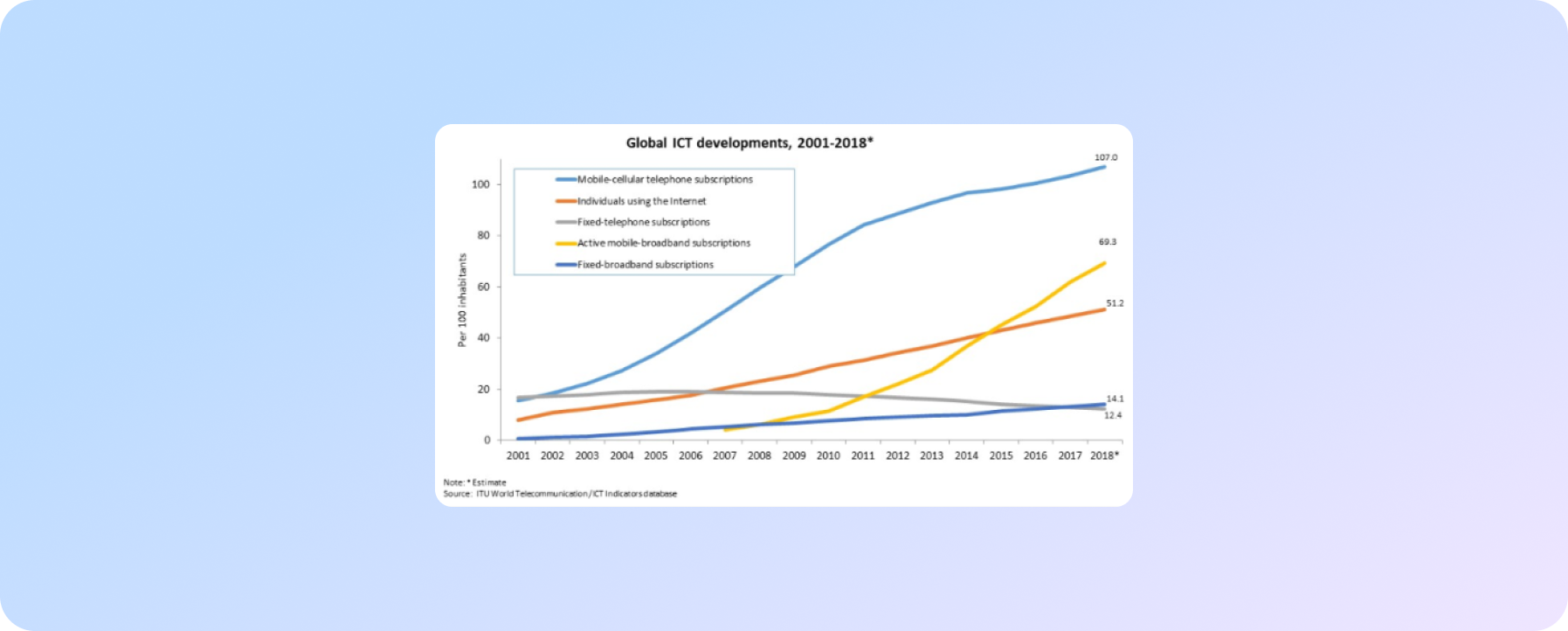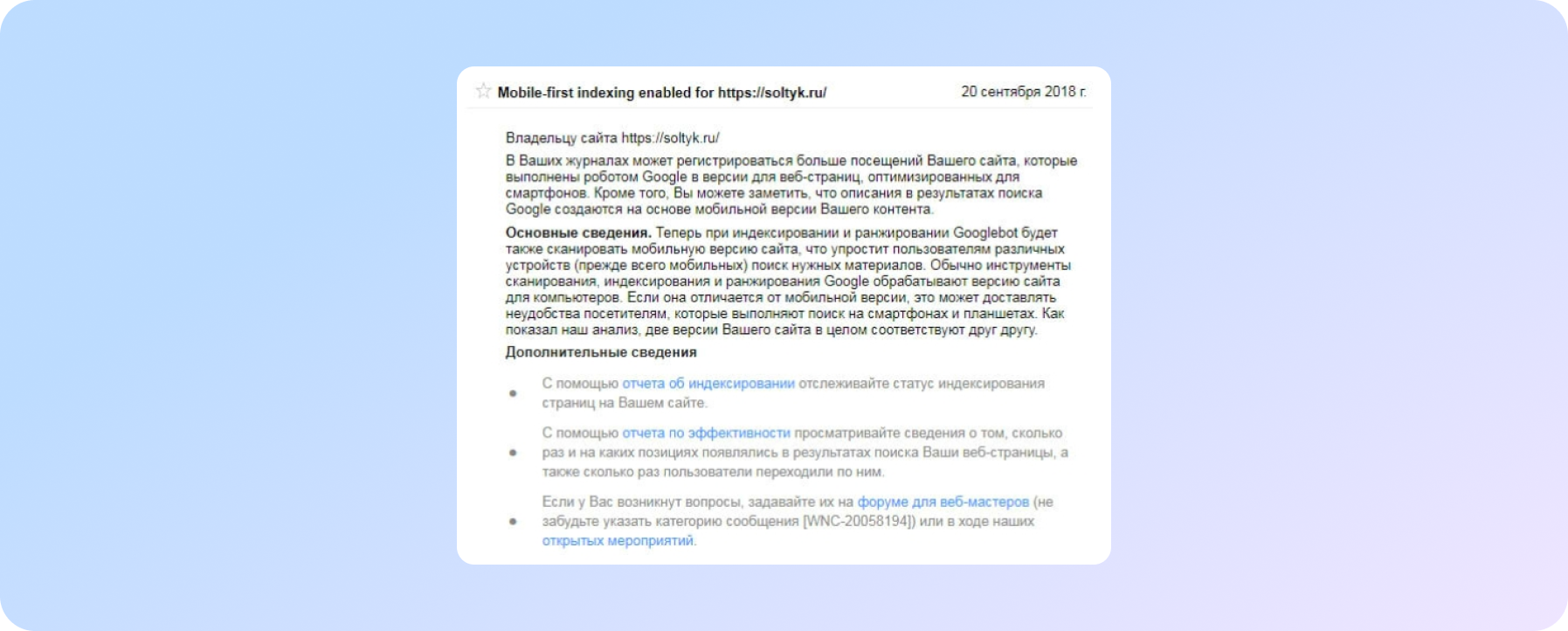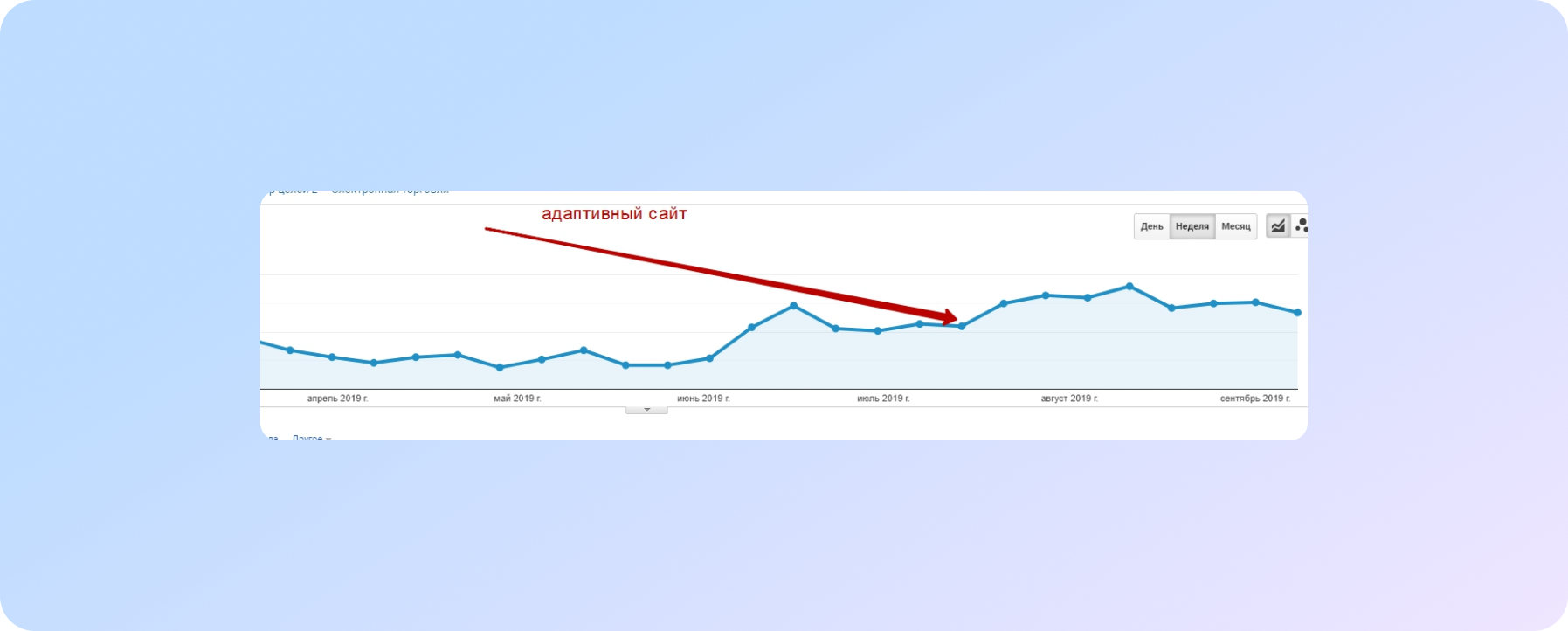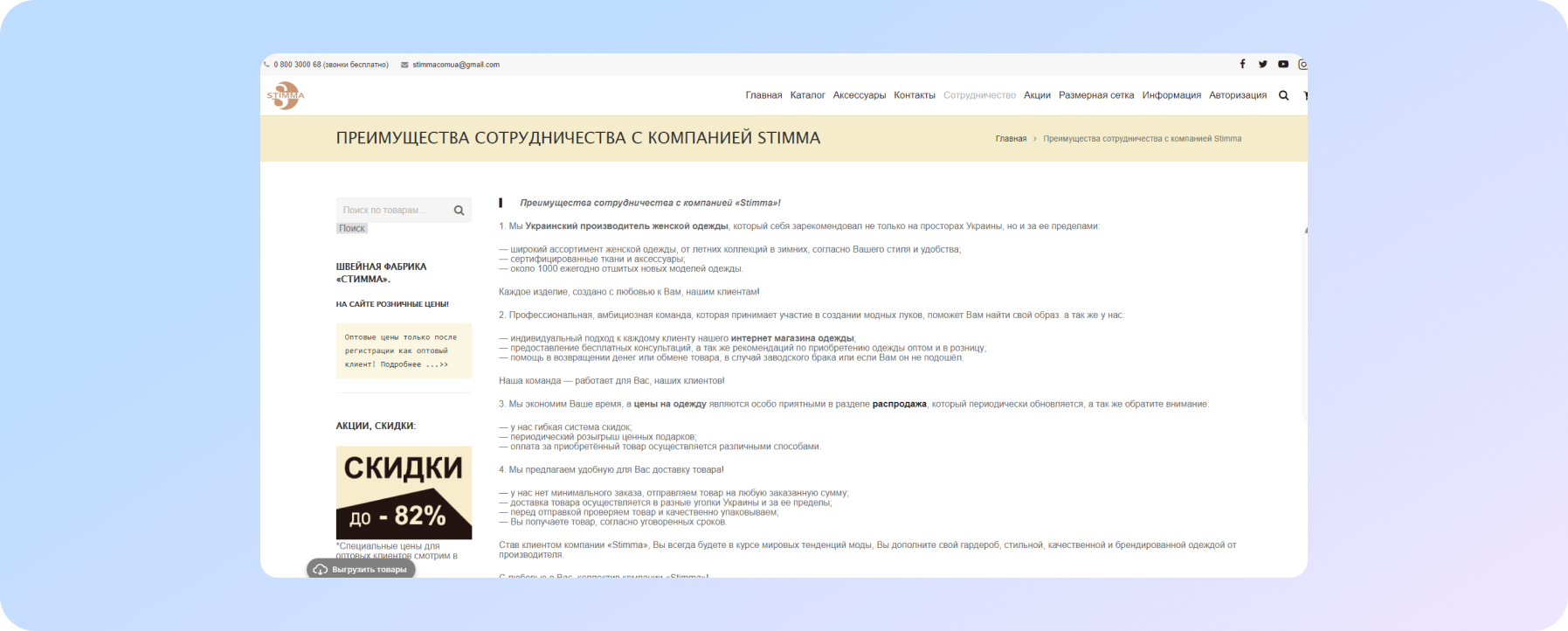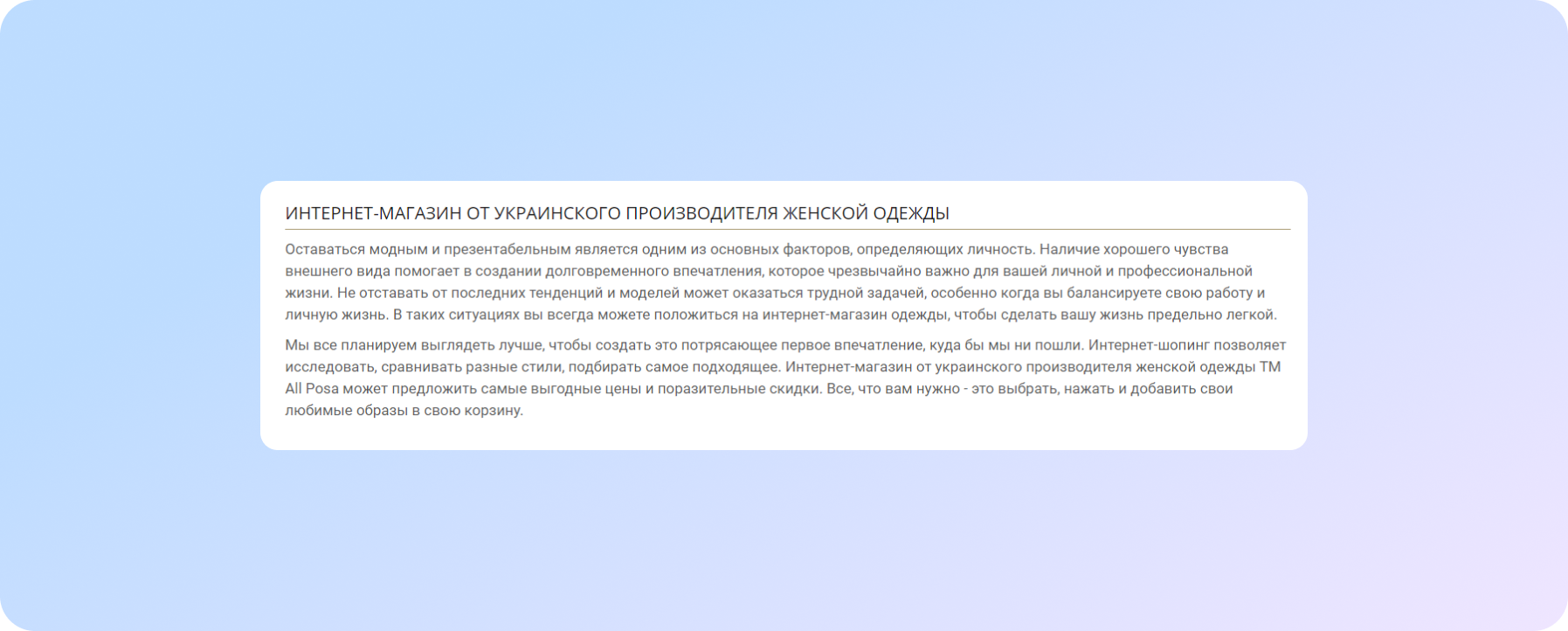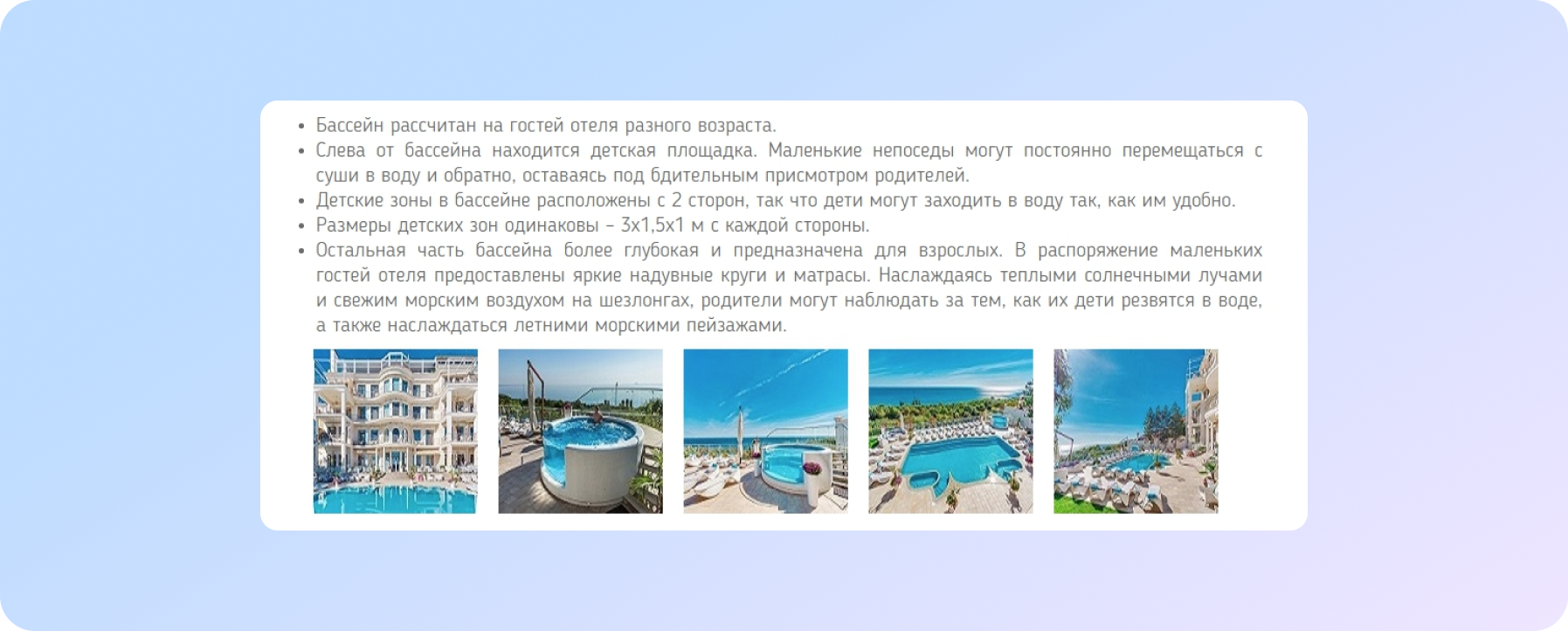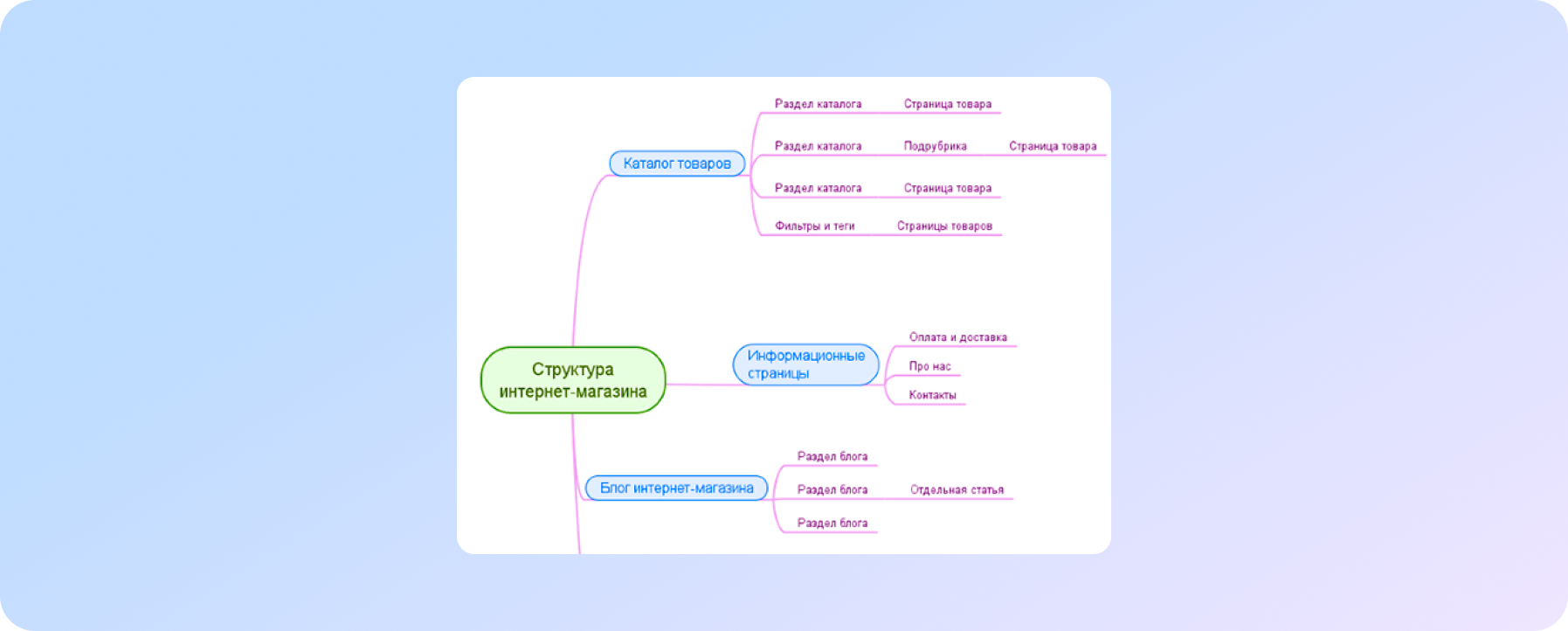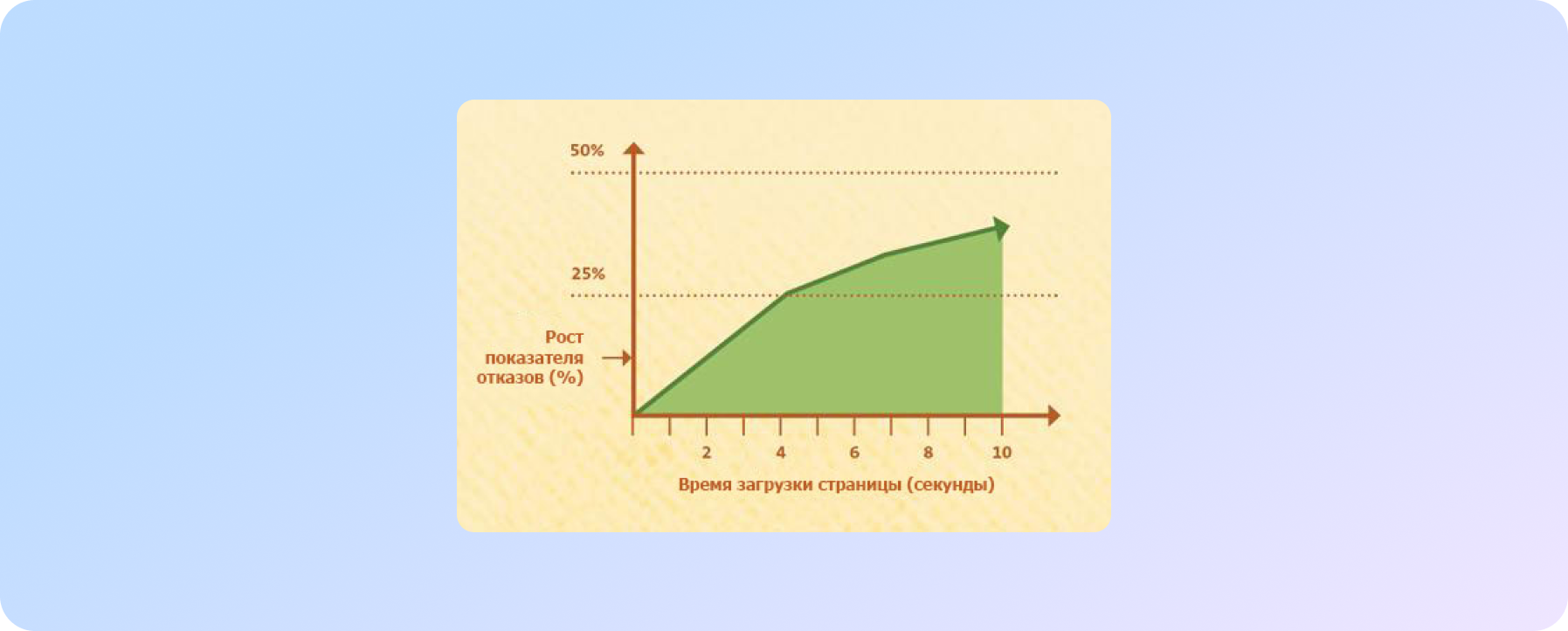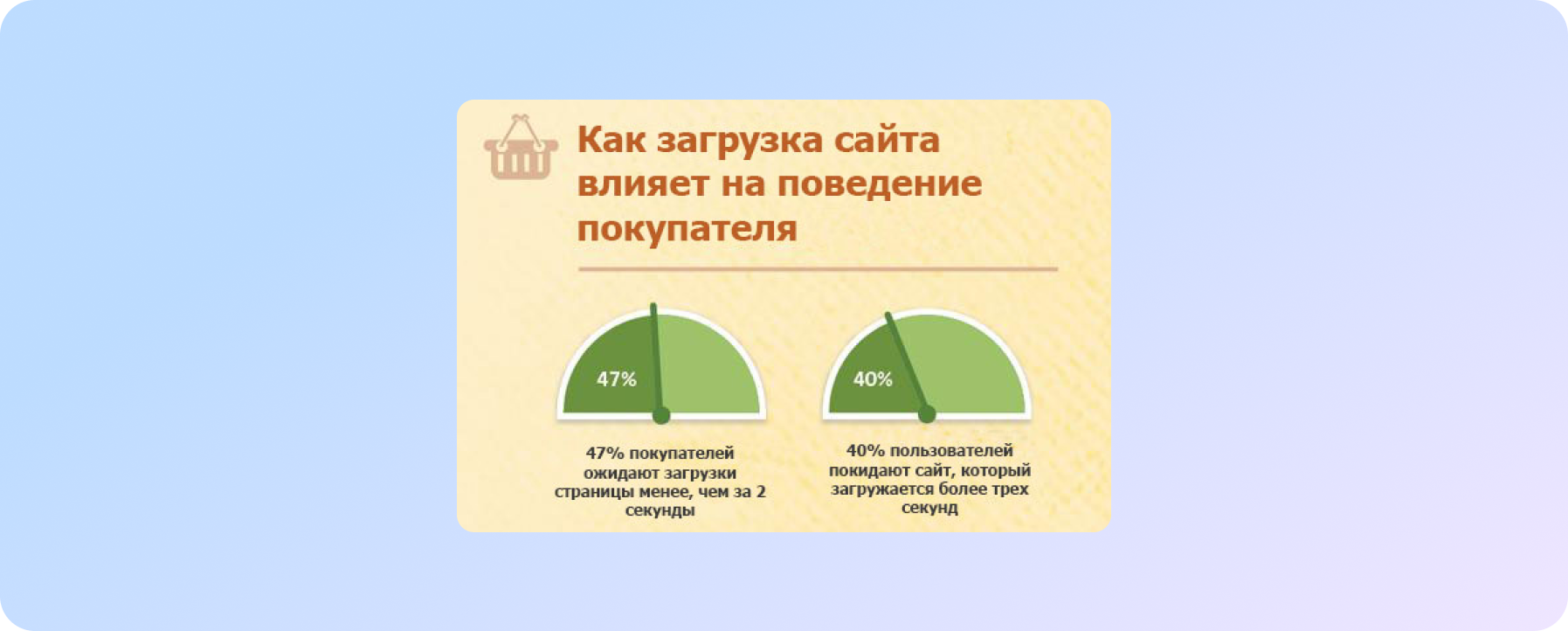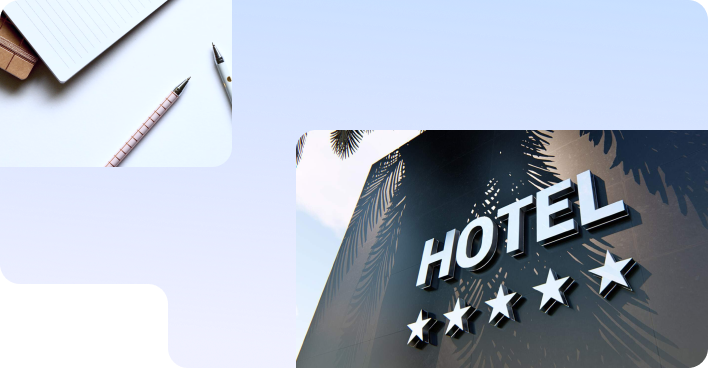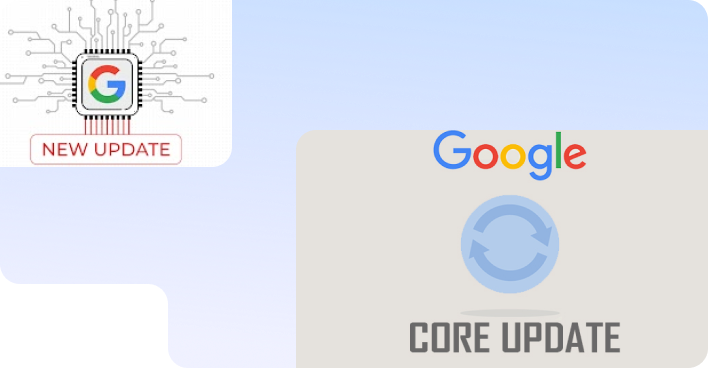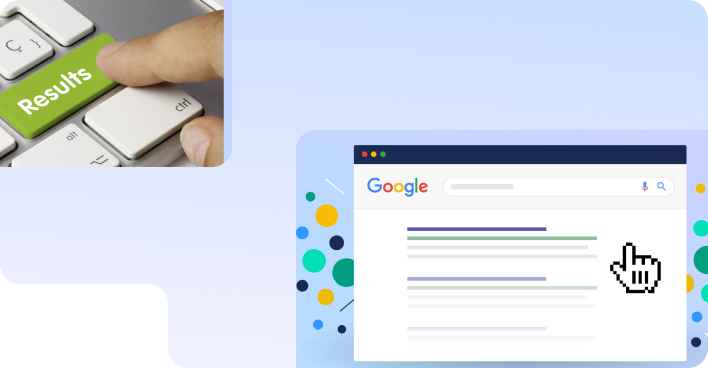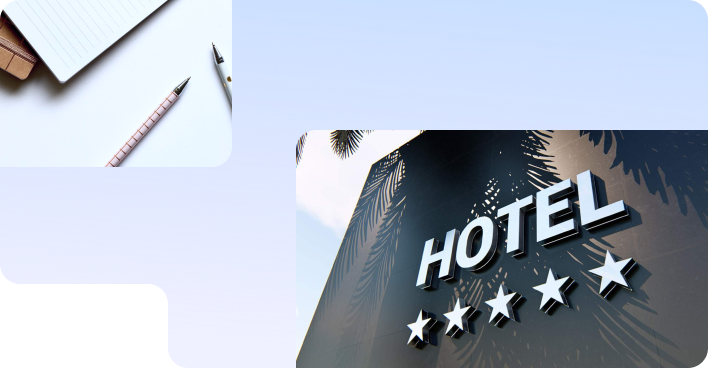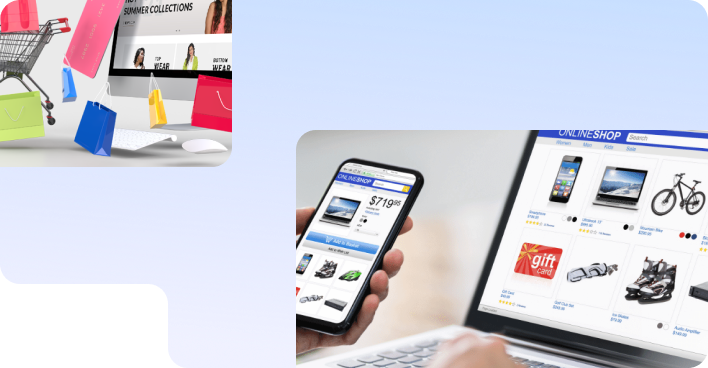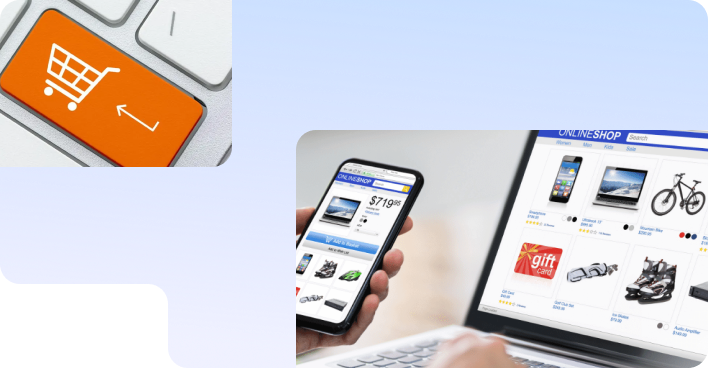No magic - just our painstaking joint work on the site
What is important in promoting a commercial website in 2020
In order for search engines to consider your site as an authoritative resource, you need to follow the tendencies and trends of search algorithms. This is the first condition for successful promotion; the second is that the content on your resource must meet the needs of users. It turns out that your task is to please both users and Google. The most common question for e-commerce site owners is: how to get ahead in search in 2020?
Read and implement. Choose the menu item you want to explore and check your resource after reading.
- Adaptability above all else
- Quality content and response completeness on the site
- Types of content on commercial sites
- Links as resource authority
- Correct site structure
- Attractive snippet
- Download speed
Adaptability above all else
The International Telecommunication Union (ITU) published a study in December 2018, which reports that the number of users from mobile devices is increasing every year.
Given this trend, search engines are adapting to the needs of the audience and trying to make the issue more attractive and user-friendly. For this reason, on November 4, 2016, Google announced a completely new approach to site indexing - Mobile-First Indexing. Now the mobile or adaptive version is a ranking factor for Google, and the indexing of pages is performed primarily by Googlebot for smartphones.
It took off from there.
In September 2018, most of the sites were transferred to Mobile-First Indexing. Resources received this notification in Google Search Console:
Since July 1, 2019, the search engine has applied mobile content priority indexing for all new resources by default.
How can you make a website that displays correctly on a mobile device?
There are two ways:
Mobile version of the sit - an independent version of the site, hosted on a subdomain, for the correct site display on mobile devices. This method is deprecated because if changes are required, they must be made on two versions of the site at once. The disadvantages are obvious: two versions take twice as many resources to update the data and maintain two sites.
An adaptive website is a page design that automatically adjusts to any browser extension and / or device on the screen of each electronic gadget. At the same time, it will be convenient for the user to access the site from any device.
You can check if your site meets the requirements of Google using the official site for verification: Search.google.
What to consider when developing a responsive website design:
- All desktop content must display correctly on mobile devices. The sequence of blocks with text or graphic elements may change, but all texts, photos with attributes (alt and title), videos, tables must be preserved.
- All structured data must remain unchanged across desktops and mobile devices.
- Adaptive design should be simple, light, user-friendly without being overloaded with unnecessary elements. A user who gets to the site from his smartphone should already understand the site USP (unique selling proposition) on the first screen. If this is not the case, the bounce rate will increase.
- Meta tags must be filled in both mobile and desktop versions of the site. Make sure that title and meta description values are identical everywhere.
Example: The project had an outdated design and a non-responsive website. After developing a new site and transferring it to the main domain, traffic from search engines began to grow:
By the way! SPRAVA specialists develop websites for business and redesign websites taking into account the requirements for adaptability.
Contact us for website development
Quality content and response completeness on the site
What was the last time you reread the texts on your site? Do you like them? Are all the user's questions answered? Are you sure? Unfortunately, simply creating a website for its good ranking and competitiveness with sites in your business niche is not enough. The content of the site should be dealt with as carefully as the technical component.
The content of landing pages and the site as a whole is one of the most important ranking factors. It is important not only to fill the site in the development process, but also to constantly update information, supplement, create useful and interesting content, follow search engine trends and the needs of your target audience.
An example of bad text on a page:
Here you can close the name of the manufacturer and enter any other - streamlined wording, and "benefits" that everyone has, no USP, no specifics
Another bad post on this thread. Here the copywriter masks the lack of meaning with complex wording.
Good content example:
Here are the specific facts and dimensions. All descriptions are supported by photos. As a result, a person has a real idea about the hotel he is going to come to.
For you, we have developed a template for checking the content of competitors Read an article on this topic and draw ideas and inspiration from your niche.
Rules for writing good texts for the site
In order to fill the site on high quality level, I advise you to follow the following rules:
- Imagine that you are a potential buyer of a product or service from a website. Put yourself in the place of a person who came to your site for the first time and is trying to understand your offer. Go to any resource page. Is the description enough for you to buy a product or order a service? If not, what exactly is missing? Try to be critical in evaluating content. Fill in any gaps that are missing to make a purchasing decision. Approach the task skeptically, implement and describe things that are obvious and understandable to everyone even at first glance.
- Competitor analysis is required. Search engines select the best projects from the topics that meet most of the search robots’ requirements. Therefore, some ideas for filling can be peeped in the TOP-10 from competitors in your niche in your region. Analyze the search results for several priority areas of your business (use high-frequency and medium-frequency queries to study) and highlight the resources with which you have identical topics and the internal structure of the site. It matters a lot what content strategy your competitors have and how they succeeded. It is important to not mimic a competitor, but do better, without losing your individuality. The emphasis is on a complete, understandable, useful response to the user's need on every page of your site.
- The content should solve the issues of the target audience. It is necessary to collect a portrait of your target audience: gender, age, income level, interests and information requests of each segment. How to write text for a website page? Just make a list of all the questions on the page topic and answer them sequentially.
Types of content on commercial sites
- Texts. Requirements: useful, expert, revealing buyers' questions in essence, unique, without errors. The number of characters per page is determined by niche competition and depends on the average TOP-10. Texts are a ranking factor.
- Graphic content. Requirements: high-quality images, the name of the picture should correspond to its content, the picture size should allow you to easily see the details. But at the same time, it is important not to "weight down" the site, not to slow down the download speed. Graphic content is a ranking factor.
- Video content is not necessarily unique, it can be from YouTube. Used to increase behavioral factors and the user's time spent on the page.
By the way! SPRAVA specialists will help you fill your commercial site with attractive, useful and optimized content. Contact us!
Talk about content for your site
Links as resource authority
Whatever they may say, links in 2020 are one of the important ranking factors, especially for Google. Links show the search engine how popular and authoritative your resource is, how often it is referred to. For this reason, working on a link profile is important, but in order to achieve a good result, it is necessary to form a strategy for building up a link mass by compiling an anchor list - a plan for purchasing and placing links on a monthly basis.
Let's look at the types of links:
- By type placement:
- natural - links that appear due to the popularity of the brand (can be from social networks, forums, etc.);
- purchased.
- By payment method:
- rented - monthly payment for placing a link;
- eternal - payment once, placement for several years.
- Anchor type:
- anchor - the link has the key or the key part (for example, “buy screwdriver”, “Makita screwdriver”, “screwdriver”, “good screwdriver”, etc.);
- non-anchor - the anchor of the link is the URL, domain or the words "source", "here", "here", "by link", etc.;
- branded - the text contains a mention of the company's brand (for example, SPRAVA, SPRAVA company, SPRAVA promotion).
It is necessary to increase the external link mass in a complex way, the site must receive links from various sources:
- blogs;
- news portals;
- forums;
- social networks;
- sites of related topics, etc.
When compiling an anchor list, follow the rules
- Initially, it is necessary to analyze the link building of competitors both for the donor in general and for specific areas:
- the number of links to the domain;
- dofollow/nofollow percentage;
- domain zones of donors;
- ratio of links (anchor/non-anchor/branded);
- donor type.
- When choosing a site for placement, pay attention to the following visual indicators:
- how close the subject of the donor site is to ours. You can take resources and media sites of related thematic;
- the stylistic design of links should not stand out too much from the style of the entire site, it should be as concise and harmonious as possible, consistent with the design of the site;
- no explicit spam and intrusive advertising.
- Use the Ahrefs tool to analyze the value of the following metrics:
- Ahrefs Rank is an indicator based on the volume and quality of the link mass (the lower the value, the better the profile). The recommended value is up to 3,000,000;
- URL Rating - a score for the quality of the link mass of a particular page on a scale from 1 to 100. The recommended value is not less than 12-14;
- DR Rating - an indicator of the quality of the link mass of the entire donor; domain rating on a scale from 1 to 100. The higher the value, the better.
- Build links gradually, avoiding a big jump for a natural effect.
- It is better not to post links to new sites for the first 1.5-2 months.
- Put links not only to promoted pages, but also to auxiliary sections and resource pages.
- Avoid spam in anchors by using the same anchor a certain number of times.
- Don't overuse anchor links with keywords.
- Make your link profile as natural as possible.
- It is worth regularly conducting additional backlink analysis, without waiting until you reach certain indicators. Search engine algorithms are updated regularly, and in a particular niche, backlinks can become a more or less important factor. You need to quickly adapt, and not wait six months or a year; in the Internet marketing field it is important to work ahead of the curve.
A good example of building a link profile, the screen shows the period of the link building start:
It is important that in addition to links, the site on this project is regularly filled with unique and useful content, the content of landing pages is reviewed.
IMPORTANT!!! Links are not a magic pill for entering the TOP-10, but with the right and measured approach, it is possible to achieve the desired result. Links can be useful, but they can also harm the site by driving it under the search engines filter.
Contact the SPRAVA experts for promotion..
Correct site structure
The structure of a website is the logical construction of all resource pages which are interconnected.
The site structure directly depends on the queries (semantic core) for which the promotion is carried out. Ideally, according to the semantic core, a study is carried out on which folders and documents should be on the resource. Therefore, sketches of the site structure must be done immediately after collecting the semantics.
The simpler and clearer the logical structure of the site, the more resources the search robot can spare to quickly bypass the site's internal pages for the same period of time, which leads to faster site indexing. In addition, documents placed on the site correctly and logically can get into the search engine index the very next day.
Thus, a well-designed site structure has an important impact on rankings and is a factor for SEO promotion.
An important indicator for search engines is the site attractiveness for the end users. The correct page hierarchy helps the user to focus on the main actions on the site. If the structure is confusing, users will leave the site, increasing the bounce rate and reducing the time spent on the site, which will negatively affect promotion.
The correct structure of the site is important for:
- user convenience. Try to put yourself in the place of a user who got to the resource through a search or other traffic channel. How quickly can you solve your problem? How quickly can you get to the section you are interested in and find the right product or service? The user's stay on the site and the problem solution should be as simple and convenient as possible. Regardless of the current user location on the site, he should easily understand where he came from and how to get to the main page, select another product category, find contacts, etc.
- the search robots speed. If the resource structure is properly thought out, it will be easier for robots to crawl and index the entire site and not miss anything.
- Your site can have good, interesting, useful and unique content and a modern site design. But if there is no link to this page anywhere, then no search engine will be able to index it. Therefore, your target audience will not know about your product or service.
- promotion efficiency. The lower the page nesting level, the easier it is to promote it. Static weight is distributed throughout the site depending on the page nesting level. It means that, according to search engines, the main (first-level page) is the most important. Pages of goods or services categories (pages of the second nesting level) have less static weight than the main page. And the pages of each next level have less and less static weight, which must be taken into account when developing the structure of the site.
Attractive snippet
Snippet is an information block in search results with a brief description of the page content. Snippets are used to pre-familiarize users with the page: what content can be found on it and what the page is about.
It is a beautiful, attractive and informative snippet that influences the end user's transitions to the site from the search results (CTR). Thus, you can create the first impression of your resource. Whether it is positive or negative is up to you.
The standard snippet structure is the same for all search engines:
- Name.
- URL - the address where the page is located.
- Description.
But the snippet can contain additional information. The snippet title can contain data from the title meta tag, from the H1-H6 headings. The description can include text from the description meta tag or from any other piece of text on the page that contains the occurrence of words from the search phrase. Search engines take the most relevant fragment of the page for the snippet. It is necessary to ensure that the most accurate key queries occurrence can be found in the title and headings.
Even if the site gets into the TOP-10 on request, it is important to stand out, make the snippet of your resource more visible so that as many users as possible follow the link from the search results. To improve the attractiveness of the link and site description, we recommend using an expanded snippet that increases CTR (click through rate).
The most popular types of extended descriptions that can be implemented:
- Goods micromarking.
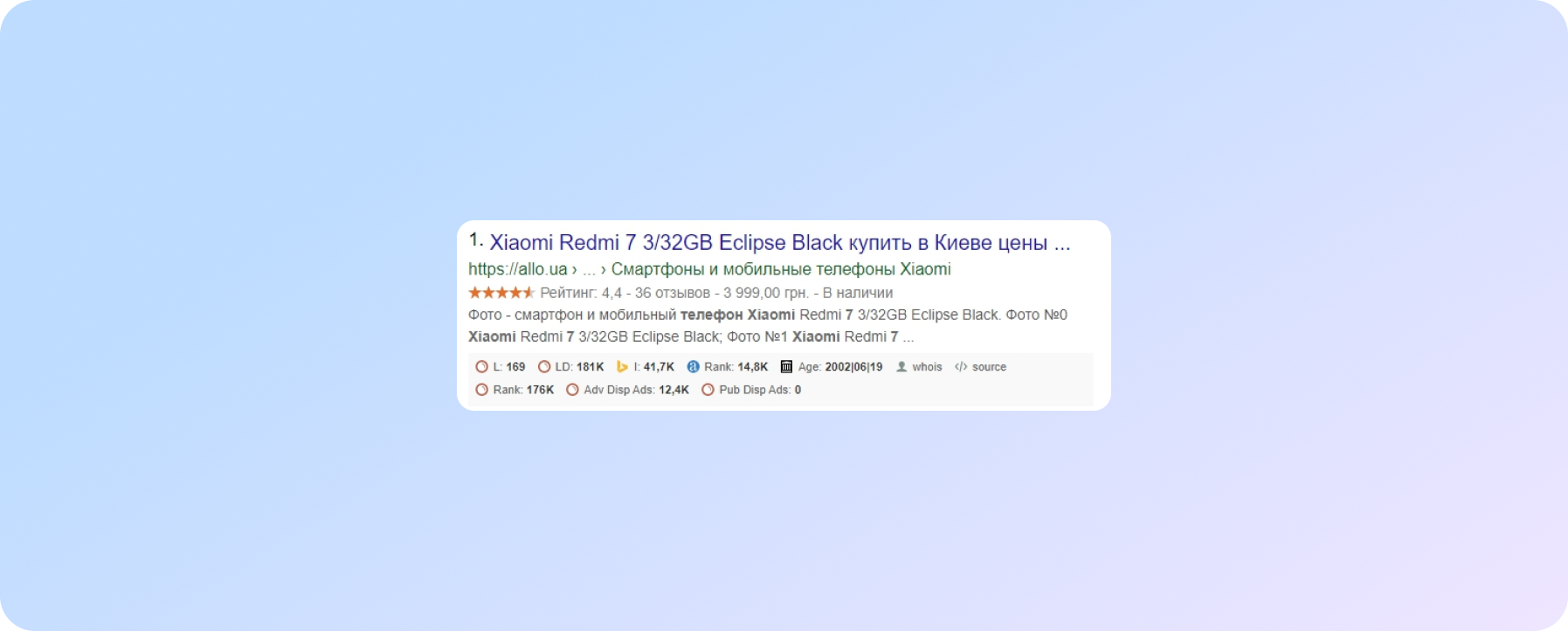
- Product categories micromarking.
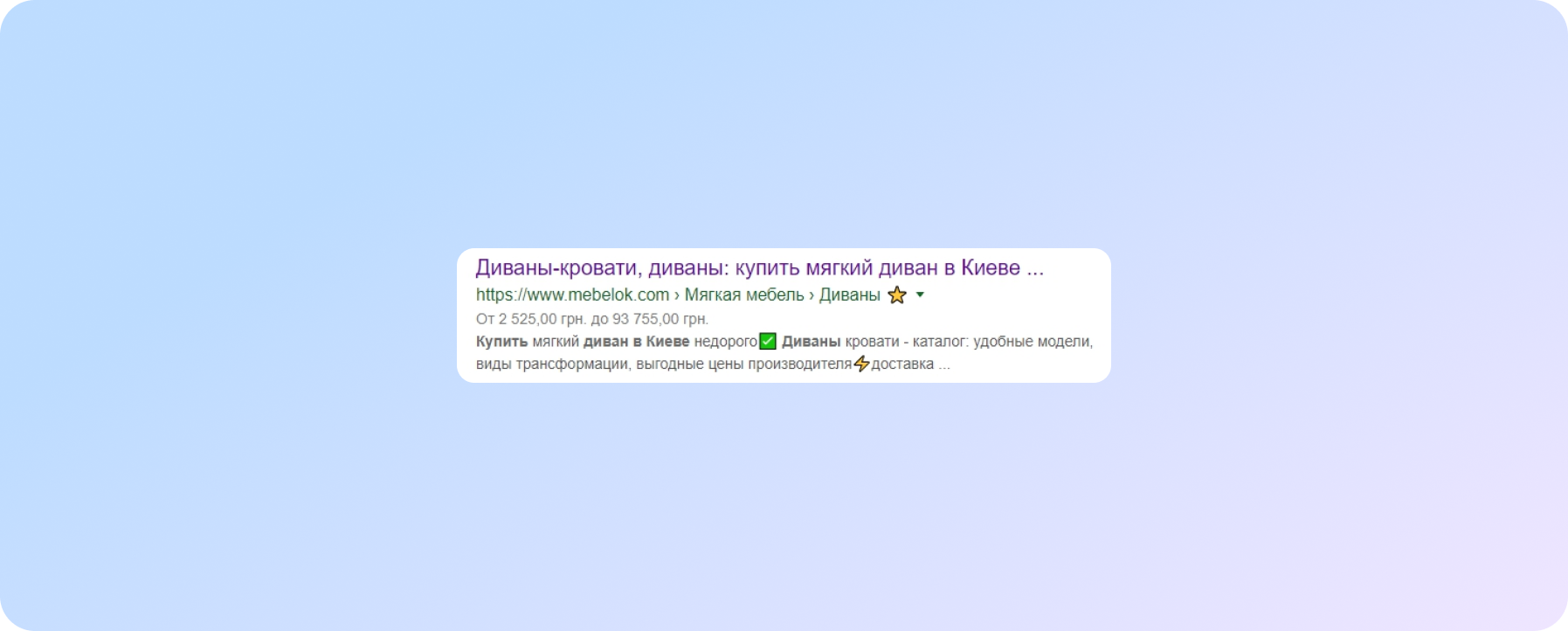
- Bread crumbs micromarking.
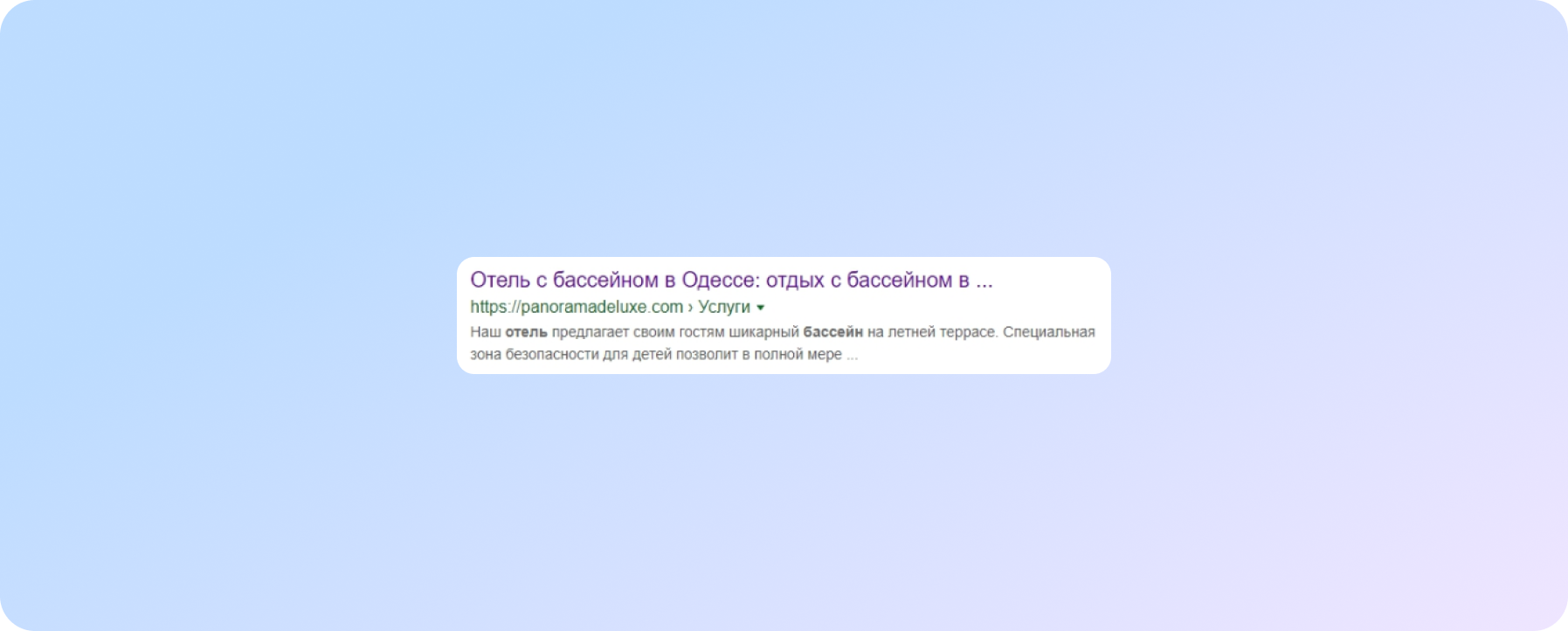
- Search markup.
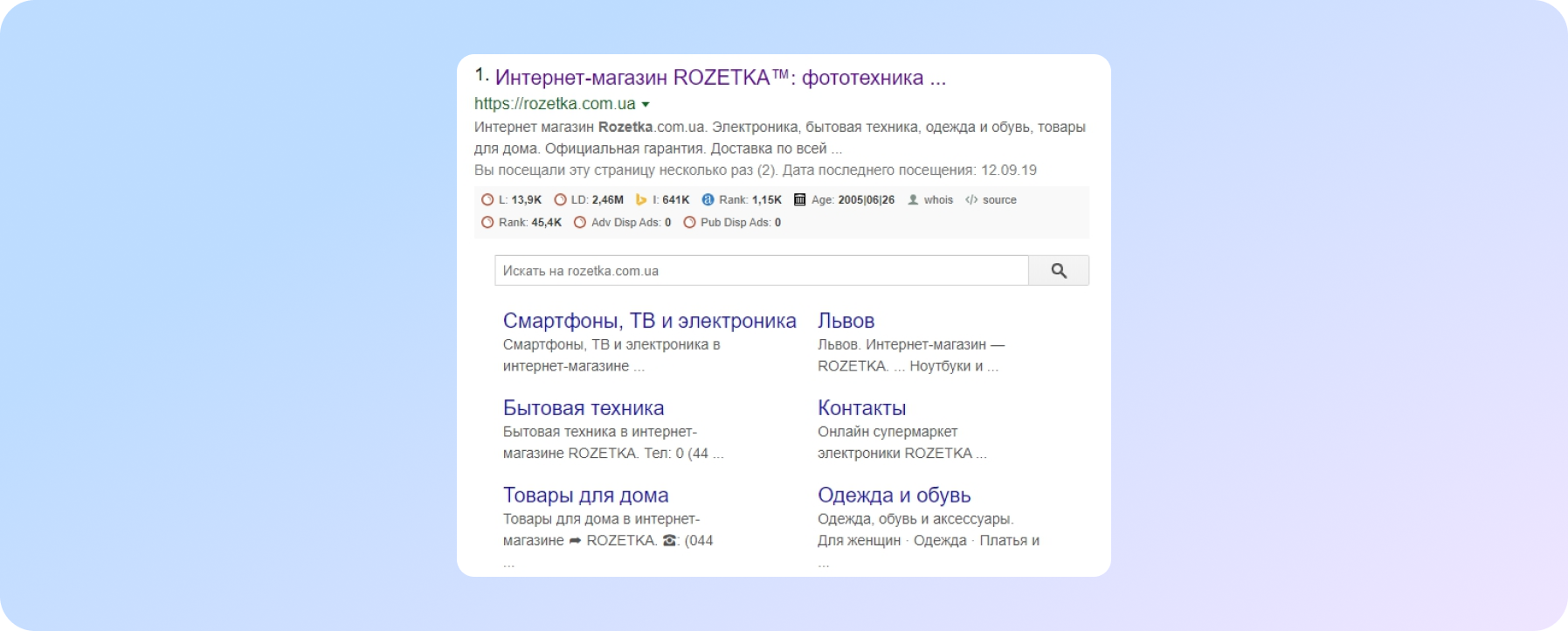
- Organization micromarking.
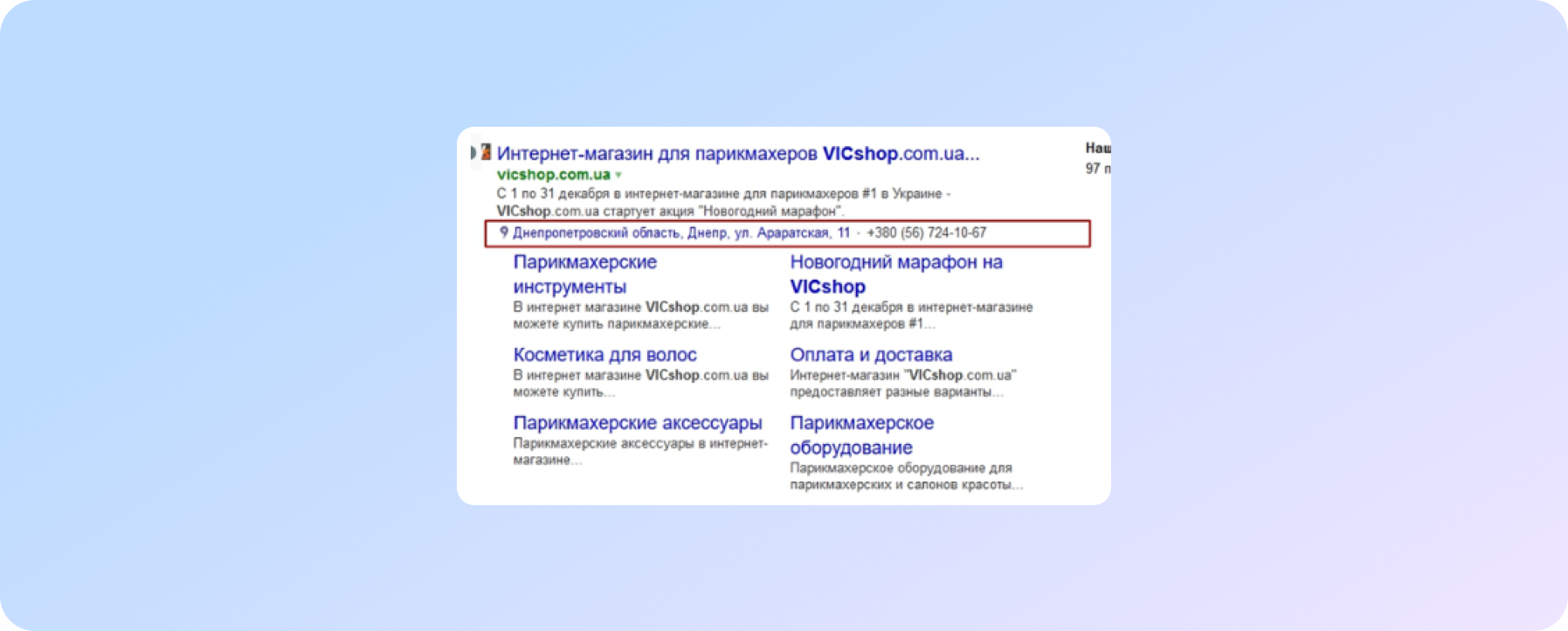
- Rating markup.
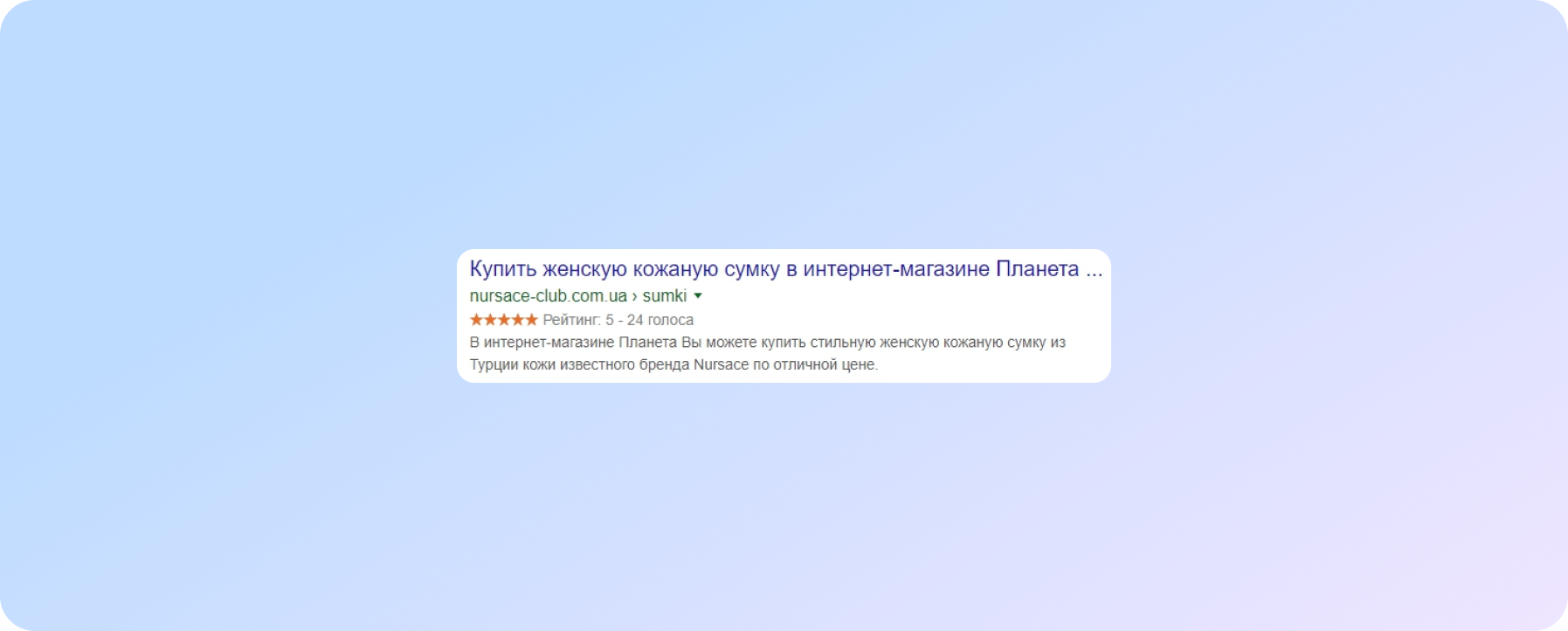
The Google search engine has featured snippets (a block with answers that occupies a zero position and is shown immediately below the ad block). The snippet takes up much more space on the screen, its click-through rate is much higher.
And we can help you with snippets too. Contact SPRAVA SEO-specialists, and we will get your tasks done =)
Download speed
Internet users will not have the patience and desire to waste time on too slow sites. Therefore, a low resource loading speed leads to an increase in the bounce rate:
According to kissmetrics.com statistics:
- 47% of users expect a page to load in under 2 seconds. If there are problems with the download, they simply go to another resource.
- Loyal users who will wait for loading more than 3 seconds are only 13% of the total number of users, which is negligible.
A website page loading can be called slow if it takes more than three seconds.
The normal loading time of the site is up to 2 seconds.
Tools for checking site loading speed indicators:
The simplest methods to increase site loading speed:
- Choose a reliable hosting and a tariff plan that will “hold” the load of your site on the server, and make the appropriate settings so that the hosting optimizes those processes that depend on it, such as caching.
- Connect modules and scripts to the site only as needed, do not install those that the site will not use.
- All images should be uploaded only in the size that will be used on the site. If the original image is larger than the size used, it must be compressed.
By the way! We develop websites on our own CMS, which is made for commercial sites. It loads fast, management and administration is easy, you can even create a landing yourself, without a programmer.
Successful website promotion factors
The most important factors in website promotion for search engines:
- correct site display on mobile devices;
- high-quality texts "for people" with the answer to all the user's questions;
- good site link profile;
- logically understandable site structure for easy navigation through all sections of your products and services;
- an attractive snippet in the search results to increase clickability and distinguish you from competitors;
- fast loading speed of the site and its individual pages.
By following these rules, the site will feel more confident in the search results. Don't know where to start? SPRAVA specialists will be happy to help your business become better in 2020.
We care about improving your sales :)



